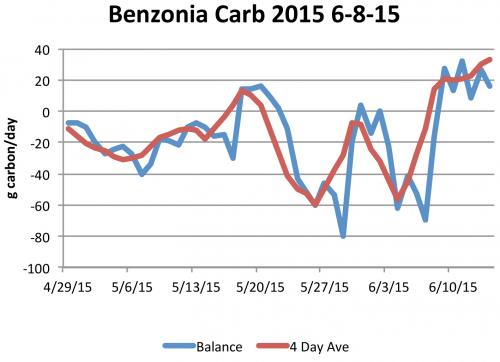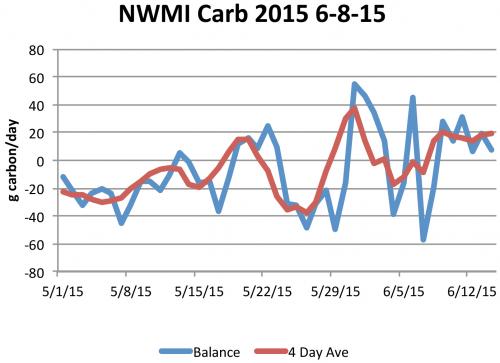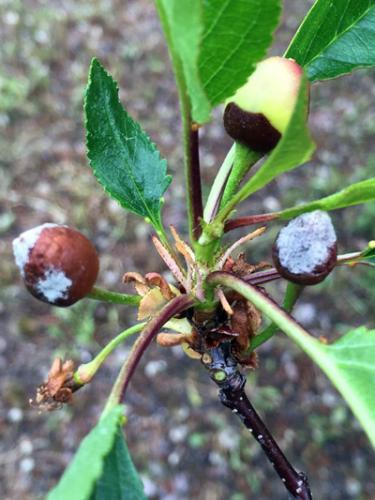Northwest Michigan fruit regional report – June 9, 2015
Predicted stormy and wet conditions will be challenging for preventing disease infections this week.

Weather report
Overall, daytime temperatures feel seasonable if we look back at the weeklong summary: high 60s and into low 70s. However, it feels more like the conditions have been cool and wet. Sunday, June 7, we had 0.54 inches of rainfall. The rains moved out Sunday evening and then moved back in again for a short period Monday afternoon when we received less than 0.1 inches of rain. Rains cleared again Monday evening and were replaced by a fog that is still sitting over the region today, June 9. These wet conditions are concerning for disease development. We have accumulated 783 growing degree days (GDD) base 42 and 418 GDD base 50. As in past weeks, these degree-day accumulations are spot-on with our 25-year average.
Crop report
In grapes, many vinifera vineyards still look very bad, with only a few live shoots rising from the base of the vines. More fortunate sites are in the 6- to 8-inch shoot stage with a small crop showing now. We’ve seen a few sites that were left un-pruned that have 6- to 8-inch shoots at the base and just bud swell to 2-inch shoots higher in the vine. We suspect these late shoots will not survive long into the growing season as the cambium tissues in the canes are too damaged to keep up with their needs once the stress of fruit development starts.
Earlier hybrid varieties are approaching the 12-inch shoot stage with a fair crop showing where there was not damage from the May freeze.
Adult potato leafhoppers and rose chafers are now present in the Grand Traverse region.
The first wine grape variety trial at the Northwest Michigan Horticultural Research Center (NWMHRC), planted in 1995-1998, was pulled out today, June 9. Many thanks to all NWMHRC staff, industry people, students and volunteers who helped maintain, harvest and gather research data from this block of vines over the years!
Saskatoon fruits are sizing a bit now and fruit-infesting insect activity continues. Apple curculio adults are still laying eggs. The first hollowed-out berries have turned deep blue-black and are beginning to fall. Leafroller larvae are approaching full size; their feeding injury should stop soon. Rose chafer adults are now active. Their feeding can be very damaging to saskatoons leaves, so Michigan State University Extension highly recommends scouting for rose chafer presence and applying treatments when numbers start to climb. Do not use insecticides with carbaryl as the active ingredient on bearing plants as this chemical will act as a fruit thinner on saskatoons. Carbaryl is a good choice for treating rose chafers on young plantings where growers do not wish to bear fruit on bushes.
We have noticed an upswing in the populations of lecanium scale on woodland trees in northwest Michigan. These may become an issue on saskatoons in the next couple of years. We have seen more saskatoon-juniper rust this week, but relatively little Entomosporium leaf spot disease.
Tree fruit growers are primarily concentrating on disease control with these long wetting periods. They are still assessing their crop from the May 20 freeze event. Sweet cherries are variable throughout the region, but the current estimate remains between 40-60 percent of a full crop. Unfortunately, we have seen frost scars on some of our sweet cherries here at the NWMHRC; growers should be sure to keep these developing fruit covered, particularly with warm and wet weather in the forecast as these conditions are conducive for American brown rot development.
Tart cherries are also variable, but growers have been pleasantly surprised to see more cherries coming out of the shuck in the past week. At this time, growers are still estimating the region has about 50 percent of a crop. Young blocks appear to have a heavier set than older trees.
As a result of the May 20 frost, growers are concerned about thinning apples. The Benzonia and the NWMHRC carbohydrate models are showing moderate to high stress today, but the model indicates we will be moving out of time-of-stress soon. Growers that plan to thin in the next day should use moderate to reduced amounts of thinners. In the next few days (past June 10), growers will need to increase thinner rates as we will move into a period of no stress. Additionally, at the NWMHRC we are at the optimal time for thinning as our fruit is between 9-11 millimeters.

The Carbohydrate Thinning Model for Benzonia, Michigan, as of June 8, 2015.

The Carbohydrate Thinning Model for the Northwest Michigan Horticulture Research Center as of June 8, 2015.
There is tremendous variability of a crop between trees within an orchard, which has been a big challenge for making thinning decisions. For example, some trees still have over 35 fruit while adjacent trees have only six fruit, and many growers are wondering if they should thin these types of blocks to be sure to maximize yields. MSU Extension educator Phil Schwallier recommends that in most cases, all growers will need to thin their apples, even if they just thin the tops of trees. Trees that have only a few fruit on them will be very difficult to thin. From past experience, trees with a light crop will have little competition between the few fruits left on the tree, and most likely, even at higher rates, thinners will not thin these fruits.
Schwallier recommends using Sevin plus NAA (10 ppm) unless growers have young trees or varieties that thin easily, then he recommends 5 ppm NAA with the Sevin. Even if growers are nervous about thinning due to variable crop size, we recommend thinning tops of trees and if needed, come through later in the season with hand-thinning on bottoms of trees. Hand-thinning whole trees will be a huge labor expense, plus it is much easier to thin just the bottoms of trees. If a grower is concerned about return bloom, particularly in blocks that will be hand-thinned, we recommend NAA sprays later in the season. We also recommend these sprays go on at five weeks, seven weeks and nine weeks after full bloom; growers should use a rate of 5 ppm of NAA, and these applications should not be used if temperatures are over 80 degrees Fahrenheit.
Pest report
Conditions were relatively dry for most of last week, but wet, humid weather returned and has been consistent since Sunday, June 7. Most of the northwest region has been in a long wetting period since Sunday and infection periods began for many diseases following Sunday’s rain. Recent wet conditions have been particularly challenging for growers to keep green tissue and developing fruit covered and protected from pests and diseases. Thunderstorms are predicted for this evening, June 9, and an additional storm system is forecasted to arrive Friday, June 12, with the potential for a long wetting period intermixed with heavy rainfall. Trauma blight could be a concern if we have severe conditions with heavy winds that accompany these storms; damage to leaves from hail or wind allows for fire blight bacteria to enter damaged tissue. Several other wetting events are also predicted for the week, and it will be challenging to keep tissue protected from diseases, particularly if windy conditions preclude applications. Disease levels remain low in most orchards and we encourage growers to continue being diligent with their disease programs to prevent disease infections in the coming week.
Last week, we reported cherry leaf spot lesions had been observed on oldest true leaves. This week, new cherry leaf spot lesions have appeared on newer leaves, indicating this new infection likely occurred during one of the more recent wetting events – likely during the long wet spell at the end of May. Overall, the level of cherry leaf spot infection in orchards remains low, but growers will need to keep green tissue protected during this week’s wet conditions. Many growers are at first cover in their tart cherry programs, and powdery mildew is a concern at this timing. Previous research at the NWMRHC has shown the optimal timing for powdery mildew control is at the first cover timing – well before the pathogen’s mycelium are visible on leaves. Control measures against powdery mildew are not effective once this fungus is established or visible on leaves.
American brown rot fungus has been observed sporulating on this season’s tart cherries that may have been damaged by freezing conditions in May or from bacterial canker. Signs of bacterial canker are showing up on tart cherry leaves and are evident in tart cherry blocks at the station.
According to the apple scab model on MSU Enviro-weather, 100 percent of spores are mature and 86 percent have discharged at this time; therefore, primary apple scab is ongoing. We did not detect apple scab spores at the monitoring site (i.e., a small block of Jonamac in Leelanau County) following Sunday’s rain. However, as mentioned previously, spore discharge has been low at this site and we cannot be certain these spore numbers are representative of other apple orchards throughout the region. Preventing infection during primary is key for minimizing the need for control of secondary scab infection, even in blocks with little or no fruit this season. Keeping scab infection low will help ensure trees maintain a healthy canopy through summer and early fall and store sufficient nutrients for winter as well as help keep scab inoculum low for the 2016 season. Apple powdery mildew is also a concern.

Apple scab spores.
Sweet cherries are out of the shuck, small green fruit are visible in tart cherry blocks and apples are sizing up in the region. As a result of this fruit development, many growers are protecting these fruits from plum curculio. The neonicotinoid insecticides, Actara and Assail, have excellent efficacy on plum curculio, and because these materials are systemic, they will also deter plum curculio feeding and egglaying, and provide curative action against eggs and young larvae that are present in fruit. Many growers applied trunk sprays for American plum borers and lesser peachtree borers last week and borer activity is ongoing at the station (three American plum borers per trap and nine lesser peachtree borers per trap). Lorsban is still the material of choice for borer trunk sprays. We have not detected greater peachtree borer activity at the station at this time.
We found the first codling moths of the season at the station this week (one codling moth per trap), but have not set a biofix for codling moths at this time. Some growers in the Benzie-Manistee area set codling moth biofix last week. Obliquebanded leafroller traps and spotted wing Drosophila traps were deployed at the station this week. We will also begin monitoring for cherry fruit flies soon.



 Print
Print Email
Email



